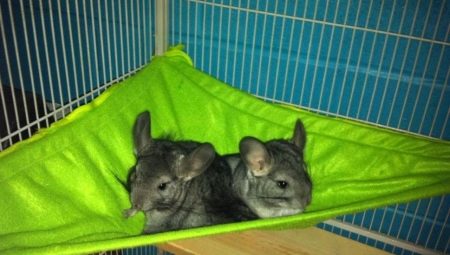A hammock for a chinchilla ... Funny thing, isn't it?
Apparently, if they try to make it and even give advice on how to make it, someone needs it. We'll figure out.
If you want (or need) to have such a rodent as a chinchilla, so that she is pleased, provide her with a small hammock. It will be both pleasant and useful for her, and will give comfort to her living area. And if the hammock is made by hand - the rodent will fully become a member of the family as much as possible.


What is it needed for
Of course, at first glance, the chinchilla is a soft, fluffy, lazy and not very mobile creature (while sleeping). But as soon as she is given freedom, she will become unusually mobile, active, bouncing and running across animals, even if she is inside the enclosure.
On the other hand, this rodent also likes to relax very, very, therefore, it is necessary to make every effort to equip a convenient and spacious home.
There should be enough space in it to play and to rest.
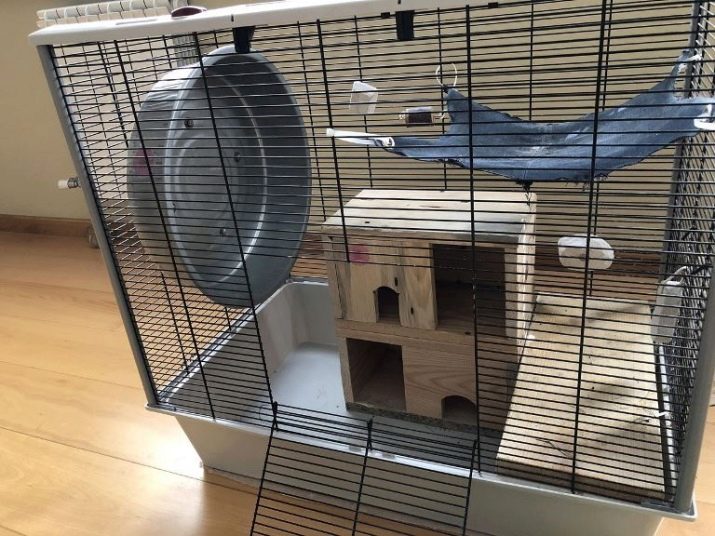
Chinchilla loves toys, and they must be different (ball, suspension and a spinning wheel), but the pet likes to relax no less, therefore it is necessary to provide passive rest, for example, in a hammock. In such a shelter, a rodent can lie and bask for hours, and sometimes also swing, as on a swing.
Is it weird? It’s strange. But only at first glance.
Zoologists have discovered an unexpected fact - it turns out that many pets are very fond of the mini-hammock. The measured swinging of the hammock provides a peaceful state in a dream, both for animals and for people.And chinchillas are also looking for protection in a suspended shelter - since it is more difficult for predators to reach it. You can drag a lot of insulating material into such a shelter and not be afraid that a relative will steal it, as if it were on the surface of the earth, and the shelter will not flood if it rains. All these reasons can motivate the owner to arrange a hammock in the chinchilla cage.
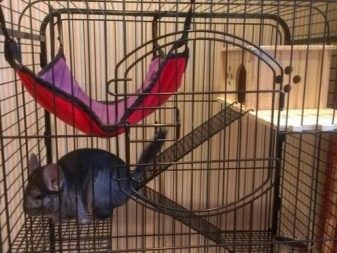

Product Requirements
The question arises - do it yourself or get ready?
There are no big differences in the design of the human hammock and hammock for the chinchilla. Both consist of elements that are securely attached to four pivot points and are some distance from ground level.
In the case when the hammock is made of fabric, it should:
- be tight enough and not give in to the teeth of a rodent;
- securely fixed to the roof / walls of the cage with carabiners or tied with such materials so that the captive chinchilla cannot gnaw them;
- have an environmentally friendly, safe and durable base of the material - it should not be torn or stretched when an animal (fleece, denim, cotton fabric) jumps on it.
Of course, the fasteners should not have sharp edges so that the rodent is not injured.

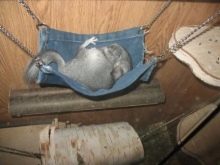

Manufacturing options
Hammocks can be one-and two-story. A chinchilla can either simply rest in it, or hide between tiers. Their height is determined by the height of the cell ceiling.
If we talk about hand-made manufacturing of a hammock, the main ones are 3 options:
- single tier;
- bunk insulated;
- cylindrical (from jeans leg).
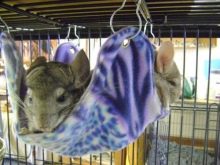

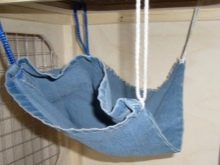
Single tier
For a hammock in one tier, it will be necessary to use a piece of the selected material (the fleece material should be chosen optimally, since it is flexible, soft and convenient for washing / cleaning) with a size of 1500/300 mm, threads, needles, scissors.
Sewing process:
- bend a piece of fabric, then bend the resulting one more time;
- stitch the surface with cells 30 × 30 mm to avoid stretching or deformation;
- mark the edges in places where there will be mounts;
- sweep loops in advance and cut symmetrically;
- when using a regular elastic band for fastening, sew it in a zigzag fashion to the edge (prepare the elastic in advance, a quarter meter from each edge);
- the edges must be strengthened in some way (stitched, protected with durable material so that the threads do not enter the pet’s stomach).
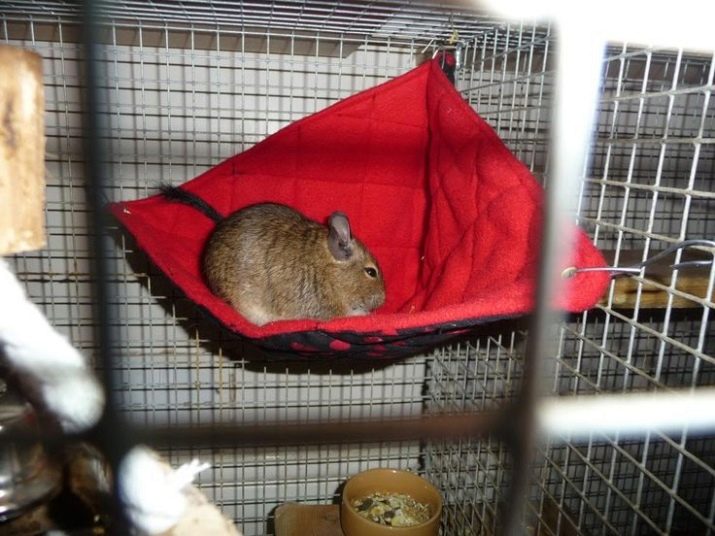
Bunk
To sew a two-story insulated bed, you have to fork out for the purchase:
- again a piece of fleece 1500/600 mm;
- for the "floor" you need a thin synthetic winterizer 1500 × 300 mm;
- slanting inline to process and strengthen sections;
- thread and needles, scissors.
The sewing process is not very different from the previous scheme, except that the hammock will be two-tiered, for which the height of the upper tier should be reduced.

Cylindrical
Jeans that will be used to make shelters for chinchillas can have the same dimensions as in the first case: 1500/300 mm (regular leg)
The sewing process differs only in that the fabric is rather coarse, not very elastic and durable, it is more difficult to sew. The question of how to design a hammock on the outside only refers to the degree and possibilities of the owner of the chinchilla. Just remember that the intense odors of evaporating chemicals must be avoided.
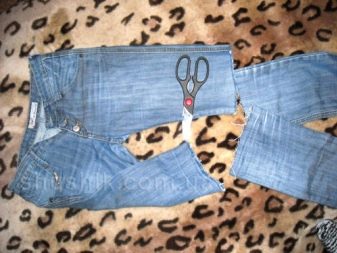



Useful Tips
Having built a hammock, do not relax. We'll have to go to the end and provide care for him, since the chinchilla herself can not do this. Yes, and serve such a hammock will be much longer.
- The hammock should not be washed less than once every 50-60 days (the fluffiness of the chinchilla is well known, and therefore it sheds).
- In addition to wool, the hammock material is covered with a layer of food (the chinchilla does not learn to eat from the tray and often drags food into the hammock).
- Washing with odoriferous substances is undesirable (a chinchilla can ignore its favorite place due to a pungent odor), ordinary laundry soap is suitable.
- If the hammock will be absent for some time, the chinchilla will be at a loss, so it is advisable to make a pair of hammocks for the washing / drying period. This will contribute not only to the fact that the chinchilla will rest, but also to the fact that the hammocks will not be very worn out and will serve for a longer time.

Each edge of the chinchilla hammock must be carefully processed:
- for the reason that she is a rodent (we don’t forget that they need to grind their teeth, they can simply die without it), respectively, they are active on the subject of “chewing - gnawing”, and the beloved chinchilla will completely sort any fabric into threads, yes and gnaws it;
- she is sure to cling to a separate thread with her claws in her rapid movements in the game.

Another important point - do not choose slippery synthetic materials in the manufacture of hammocks.
During friction, they will become electrified and beat the chinchilla (do not forget that the pet’s coat is thin) with light, but quite sensitive electric discharges. This will not be able to positively affect her temperament.
Thin tissue will not withstand the pressure of the claws of a pet (the chinchilla does not sit still for a second when awake) and will not last very long.
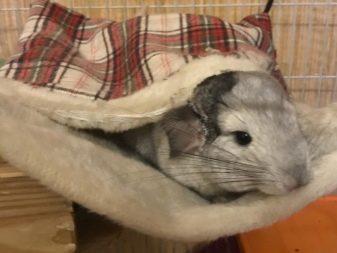
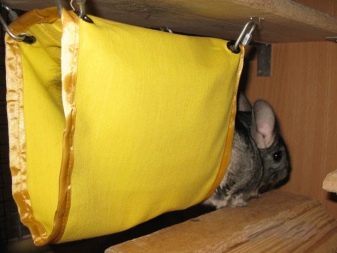
Owner reviews
Many owners of chinchillas testify - they often prefer to sleep in a hammock rather than in their mink. Such experiments were also carried out in zoos, which confirmed the commitment of even predatory cats to stay on vacation in a hammock for many hours. In hammocks photographed and predators, and herbivores, and primates. Apparently, a hammock gives them confidence in a certain security, as, for example, a jerboa is afraid of a boa constrictor, and a chinchilla is afraid of its other enemies.
On the whole, a hammock for a favorite chinchilla (of course, if it is constructed with your own hands, and in full accordance with the recommendations of this article), will fully serve the host for 4–5 years.
To learn how to sew a hammock for a chinchilla on your own, see the video below.
